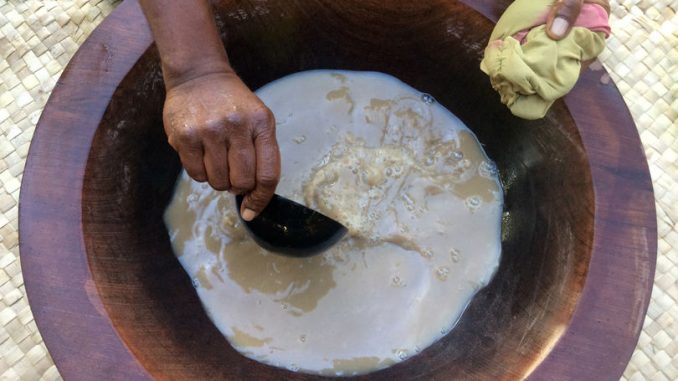
Kava Kava or to many of us don’t need to name it twice, just kava is the Polynesian plant with the intoxicating powers. It is scientifically known as Piper methysticum, hence the name ‘intoxicating pepper’.
The plant’s roots are usually ground into a pulp and added to water to form a beverage that’s been known for centuries for its tranquilizing effect. The Pacific Islanders used kava in their rituals and ceremonies, but it’s commonly used like alcohol, as a social drink, similar to alcohol.
The plant attracts its critics because of certain side effects but there appear to be corresponding health ones too.
Compounds In Kava
The active components include a unique class of lactones known as kavalactones. As many as eighteen kavalactones have been identified in the rhizome and root of the kava plant with six of the kavalactones; methysticin (M), dihydromethysticin (DHM), kavain (K), dihydrokavain (DHK), yangonin (Y), and desmethoxyyangonin (DMY), constituting 96% of the total kavalactone content. Also, a group of chalcones known as; flavokavain A (FKA), flavokavain B (FKB), and flavokavain C (FKC), are
commonly found in kava, in significantly lower quantities (Côté et al., 2004; Lebot et al., 2014).
Kava And Reducing Anxiety
A Cochrane Collaboration review in 2002 was a sytematic examination of 11 clinical trials involving 645 patients (Pittler & Ernst, 2003). A meta-analysis of 6 of those studies using the Hamilton Anxiety Ranking scale found a significant reduction (p=0.01) in anxiety using kava compared to a placebo.
Kava And Mood Improvement
Many plants which alter mood often come with a bad press. Kava kava is no exception and it may because of its similarities to cannabis. The plant produces sedation, changes in mood and a relaxing effect. There is some association with reducing anxiety and creating calmness.
One study at the Klinik für Psychiatrie und Psychotherapie, Rheinische Kliniken, in Essen, Germany has looked at a particular extract called WS 1490. The study was a randomized, placebo-controlled, double-blind multicenter study in patients suffering from neurotic anxiety. (Gastpar & Klimm, 2003).
The patients took 3 capsules of kava giving a total dose of 150mg/day or a placebo for four weeks. two weeks of observation followed. Levels of anxiety were assessed using a variety of measures and tests such as the Anxiety Status Inventory (ASI). Other tests included a structured well-being self-rating scale (Bf-S), the Clinical Global Impressions (CGI), the Erlangen Anxiety, Tension and Aggression Scale (EAAS) and the Brief Test of Personality Structure (KEPS). Taking the supplement decreased anxiety according to the observations made in the ASI, CGI and Bf-S tests but not as strong benefits as measured using the EAAS and KEPS tests.
The main components are kavalactones and flavokavains which impact on the brain and central nervous system (CNS). One randomized, placebo-controlled, double-blind study suggested that kava is an effective treatment for anxiety. The study recommended a dose of 100 milligrams of kava extract which was standardized to contain 70 per cent kavalactones be given two or three times per day.
Interactions Between Kava-Lactones And Pharmaceutical Drugs
The drug is thought to enhance the effectiveness of barbiturates and various other psychopharmaceutical drugs. This suggests the ingestion of the plant needs careful regulations.
Kavalactones are known to inhibit drug clearance in the liver by blocking the action of cytochrome P-450 which may be one of the principal reasons why it is associated with liver damage. Inhibition of cytochrome P-450 means overall drug clearance is slower which extends the lifetime of toxicity from other compounds. Taking kava is not recommended for those taking drugs that could have an adverse impact on the liver.
Toxicity Issues With Kava
One major medical issue is the possibility of liver damage which has been traditionally been witnessed in habitual users of the product. This may be due to toxicity associated with the kavalactones (Petersen et al., 2019). The evidence is disputed because direct causal links cannot be made and there may be issues with the types of solvent used to extract the kavalactones. It is likely that the benefits of kava will supercede the risks associated with taking the plant as a supplement.
References
Côté, C.S., Kor, C., Cohen, J., Auclair, K., 2004. Composition and biological activity of traditional and commercial kava extracts (https://doi.org/). Biochem. Biophys. Res. Commun. 322, pp. 147–152 (Article).
Gastpar, M., & Klimm, H. D. (2003). Treatment of anxiety, tension and restlessness states with Kava special extract WS® 1490 in general practice: A randomized placebo-controlled double-blind multicenter trial. Phytomedicine, 10(8), pp. 631-639 (Article)
Lebot,V.,Do,T.K.T.,Legendre,L.,(2014). Detection of flavokavins (A,B,C) incultivars of kava (Piper methysticum) using high performance thin layer chromatography (HPTLC). Food Chem.151,pp. 554–560. (Article). )
Petersen, G. E., Tang, Y., & Fields, C. (2019). Chemical and in vitro toxicity analysis of a supercritical fluid extract of Kava kava (Piper methysticum). Journal of Ethnopharmacology, 235, pp. 301-308 (Article)
Pittler, M.H., Ernst, E. (2003) Cochrane Database Syst Rev. (1): CD003383 .
Leave a Reply